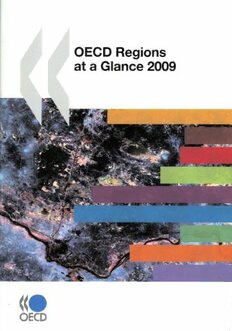
OECD Regions at a Glance 2009 PDF
198 Pages·2009·6.136 MB·English
Most books are stored in the elastic cloud where traffic is expensive. For this reason, we have a limit on daily download.
Preview OECD Regions at a Glance 2009
Description:
Well over one-third of the total economic output of OECD countries was generated by just 10% of OECD regions in 2005. This means the performance of regional economies and the effectiveness of regional policy matter more than ever. OECD Regions at a Glance is the one-stop guide for understanding regional competitiveness and performance, providing comparative statistical information at the sub-national level, graphs and maps. It identifies new ways that regions can increase their capacity to exploit local factors, mobilise resources and link with other regions. Measuring such factors as education levels, employment opportunities and intensity of knowledge-based activities, this publication offers a statistical snapshot of how life is lived and can be improved from region to region in the OECD area. This third edition provides the latest comparable data and trends across regions in OECD countries, including a special focus on the spatial dimension for innovation. It relies on the OECD Regional database, the most comprehensive set of statistics at the sub-national level on demography, economic and labour market performance, education, healthcare, environmental outputs and knowledge-based activities comparable among the OECD countries. This publication provides a dynamic link (StatLink) for each graph and map, which directs the user to a web page where the corresponding data are available in Excel?®. Table of Content : Executive Summary Defining and Describing Regions Symbols and Abbreviations I. Focus on Regional Innovation -1. Research and development expenditures -2. Personnel employed in research and development activities -3. Regional concentration of patents -4. Regional patent co-operation -5. Student enrolment in tertiary education -6. Advanced educational qualifications -7. Employment in knowledge-oriented sectors II. Regions as Actors of National Growth -8. Distribution of population and regional typology -9. Geographic concentration of population -10. Regional contribution to growth in national GDP -11. Regional contributions to change in employment -12. Geographic concentration of the elderly population -13. Geographical concentration of GDP -14. Geographic concentration of industries III. Making the Most of Regional Assets -15. Regional disparities in GDP per capita -16. Regional disparities in labour productivity -17. Regional disparities in specialisation -18. Regional disparities in unemployment rates -19. Regional disparities in participation rates IV. Key Drivers of Regional Growth -20. Overall regional performance -21. Regional factors and performance -22. Regional factors: Population and GDP per capita -23. Regional factors: Labour productivity -24. Regional factors: Employment, participation and ageing V. Competing on the Basis of Regional Well-being -25. Health: Age-adjusted mortality rate -26. Health resources: Number of physicians -27. Safety: Reported crimes against property -28. Safety: Reported murders -29. Environment: Municipal waste -30. Environment: Private vehicle ownership -31. Voter turnout in national elections -32. Access to education Annex A. Regional Grids and Typology Annex B. Sources and Data Description Annex C. Indexes and Formulas
See more
The list of books you might like
Most books are stored in the elastic cloud where traffic is expensive. For this reason, we have a limit on daily download.
